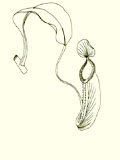

 |
 |
Flora (print pdf)
What eats Ilex chapaensis fruits?
by Anita Tsang, William Trewhella and Emma Long
Among all the Ilex species (hollies) found in Hong Kong, Ilex chapaensis produces the largest fruits. In the literature, it is stated that the fruits are black in colour. However, we have only seen green fruits, both on the trees and on the ground. With a size of 14 - 19 mm in diameter, there are only a few Hong Kong bird species that can swallow the whole fruits and the green colour is unlikely to attract birds. It has been suspected that bats eat I. chapaensis fruits, as the fruit skins and pyrenes (seeds) were found on the ground, which is a feature of how fruit bats feed (Corlett, per. comm.).
Recently (15 October), a lot of green fruits, fruit skins and pyrenes were found on the ground under an Ilex tree at Mt. Nicholson, Hong Kong Island. Therefore, on 28 October, we visited Mt. Nicholson, hoping to witness the bats that we suspected were eating the fruits. We started at 5:45p.m. (just before dusk) and watched for 1.5 hours to see if any bats visited the tree. Although we saw no bats we were able to identify the real frugivorous culprit - a masked palm civet (Paguma larvata). We heard and saw this animal climbing about in the canopy of the Ilex tree. It ate 10 - 20 fruits, dropping several on the ground, which we saw were like the previous fruits seen underneath the tree. What surprises us is that it removed the fruit skin and ate the fruit tissue inside, leaving fruit skins and pyrenes to fall to the ground. This indicates that civets are smart frugivores. In Hong Kong, masked palm civets are considered important dispersers of large seeded plants (Goodyer, 1992), and from our observations it would appear that they may also help to disperse I. chapaensis.
Bibliography
Goodyer, N. J. (1992). Notes on the Land Mammals of Hong Kong. Memoirs of the Hong Kong Natural History Society 19: 71-78.
|
|
P.14-15 |
|
Porcupine! |
 Copyright © 2000 |